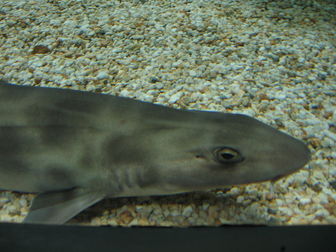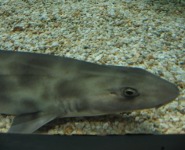Whiskery shark
Reproduction is ovoviviparous, with 5 to 24 pups in a litter, 20 to 25 cm long at birth.

Original source: Melbourne Aquarium Author Joe Bennett
Author: Joe Bennett
The Whiskery shark lives in the demersal, marine, depth range - 220 m environment.
The Whiskery Shark - The Mysterious Chicken of the Sea
 The Whiskery Shark has been commercially fished by humans since the 1940s, yet relatively little is known about this animal's behavior and social structure. With other less interesting species receiving extensive study, why does this shark remain shrouded in mystery?
The Whiskery Shark has been commercially fished by humans since the 1940s, yet relatively little is known about this animal's behavior and social structure. With other less interesting species receiving extensive study, why does this shark remain shrouded in mystery?
The Whiskery Shark (Furgaleus Macki), averages around 20-25cm or 8-10 inches at birth. Average adult length of males is 110-135cm or 43-53 inches, females 110-132cm or 43-52 inches. The heaviest weight on record is 12.9kgs or 28lbs. The average number of pups per litter is 9-10, but up to 24 is possible.
The diet of the Whiskery Shark consists of octopus, squid, fish and even lobsters. With this refined taste in food it's no surprise that this poor little ocean creature is considered very tasty by land-dwellers since the diet of an animal tends to influence the flavor of its flesh. Despite the Whiskery Shark's limited range, it is eaten quite heavily by humans under different generic names. Few meats are that ambiguous, except perhaps chicken. Maybe the Whiskery Shark is the true chicken of the sea, since tuna has it's own distinctive flavor and is easy to identify among other varieties of fish.
This type of shark has been overfished since the 1940s, though recent advances in fishing techniques have increased the amount of Whiskery Sharks taken from the ocean immensely. An estimated 75% reduction of virgin population mass puts this animal in real danger of extinction. However, population levels have held steady since the mid 1980s due in large part to the restrictions Australia has put in place regarding the fishing practices surrounding this animal. As long as these rules are enforced, the Whiskery Shark should be safe. The shark is considered harmless to humans.
In physical appearance the Whiskery Shark is elongated and slender, even more so than the average shark. It has anterior nasal flaps which elongate into barbells. The snout of the shark is broad and short and the nose is separated from the mouth. The eyes are dark and oval in shape. Teeth are very sharp and blade-like. The dorsal fins are similar in size and tend to be symmetrical. The dorsal fins are always larger than the anal fin.
Coloring of this animal changes with age. Young specimens have dark blotching all over the body and tend to be a creamy white color. As the age of the animal increases the body darkens to a more brownish shade and it's not uncommon for the blotching to disappear completely. In darker colored adults, the underside remains pale in comparison to the rest of the animal.
The Whiskery Shark has been called by a variety of other names including Flake, Reef Shark, Snaky and Sundowner.
Picture of the whiskery shark by Joe Bennett, licensed under Creative Commons Attribution 2.0 Generic license.
Common names
Cazón bigotudo in Spanish (español)
Emissole moustachue in French (français)
Furgaleus macki in French (français)
Knurhårshaj in Danish (dansk)
Mack's whiskery shark in English
reef shark in English
Shakey shark in English
Snorvaalhaai in Dutch (Nederlands)
Sundowner in English
Whiskery shark in English
whiskery skark in English
怒鯊 in Mandarin Chinese
怒鲨 in Mandarin Chinese
麥氏怒鯊 in Mandarin Chinese
麦氏怒鲨 in Mandarin Chinese


Original source: FishBase
Permission: Some rights reserved
Family : Triakidae
Genus : Furgaleus
Species : Furgaleus macki
Authority : Whitley, 1943
